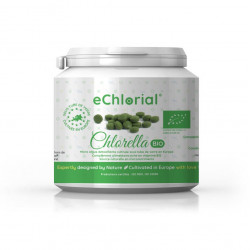Efficiency and digestibility between different Chlorellas, especially broken cell chlorellas?
Is there a difference in digestibility between the varieties of chlorella found on the market?
The answer is NO
But there is an explanation for the fact that some companies recommend their chlorellas with broken membranes under the false pretext that they are more digestible!
Some companies communicate widely on an information according to which the cells of Chlorella must be burst to be more digestible. This information is false. There is evidence and an explanation for this, given in the following :
Chlorella Grown in Glass Tubes

The evidence
Comparative studies have been conducted on small animals such as rats (*). They confirm that in both states, split or intact, Chlorella cells have a comparable digestibility. Chlorella has an average digestibility of 80% due to its proportion of fibers that are not assimilated by the body (20%).
The membrane of Chlorella opens naturally in an acid environment. It will find, in our stomach, an acidity largely sufficient to release its invaluable contents.
The explanation
It is important to know that Chlorella grown in outdoor tanks are highly loaded with microorganisms of all kinds and origins. In order to make them consumable, they must undergo a cleaning treatment. It can be a heat treatment but it is not used because it directly reduces many properties of the alga. Physical treatments are preferred such as the use of mechanical filters and high pressure treatments. These physical treatments are effective in purifying the environment but, in doing so, they greatly mistreat the Chlorella cells. Indeed, they cause the bursting of the membranes. The burst cells release their contents into the environment. Their precious components, taken out of their cellular shelter, are then exposed to degradation. This is the case, for example, for antioxidants and unsaturated fatty acids (omegas), which are sensitive to oxygen in the air.
Choose integrity and quality
It is preferable to consume well-sealed organic chlorella that will keep their precious content intact.
Chlorella grown in glass tubes (in photobioreactors) guarantee a high level of hygiene and safety. They grow in natural light and do not undergo any stress in their production process to give an intact product. The content of the Chlorella must remain well protected by its membrane. The integrity of the algae is the guarantee that it contains all its properties.
The cultivation in a controlled environment, closed to all possible external contaminations, is also a guarantee of the purity of the algae.
eChlorial’s chlorella is produced according to international quality standards. Its certifications cover the entire production chain of micro-algae, including cultivation, tablet production, packaging, logistics, etc., i.e. the entire quality management system.

I’m looking into incorporating chlorella and spirulina into my daily intake. There are so many claims from varying sources about every superfood. I just read from one company’s website that they ferment their chlorella. Is your chlorella fermented? Is fermentation of chlorella a gimmick or a beneficial process for healthful intake of chlorella? Why, or why not.
Fermenting chlorella is merely another way of growing chlorella, it is not an extra step process. Fermented chlorella grows in a closed, controlled environment, however it does not use natural light to develop, but sugar, and its composition is different that more naturally grown chlorella like pure chlorella grown in glass tubes which contains vitamin B12, for example. For more information about this, see Different ways of growing micro algae.